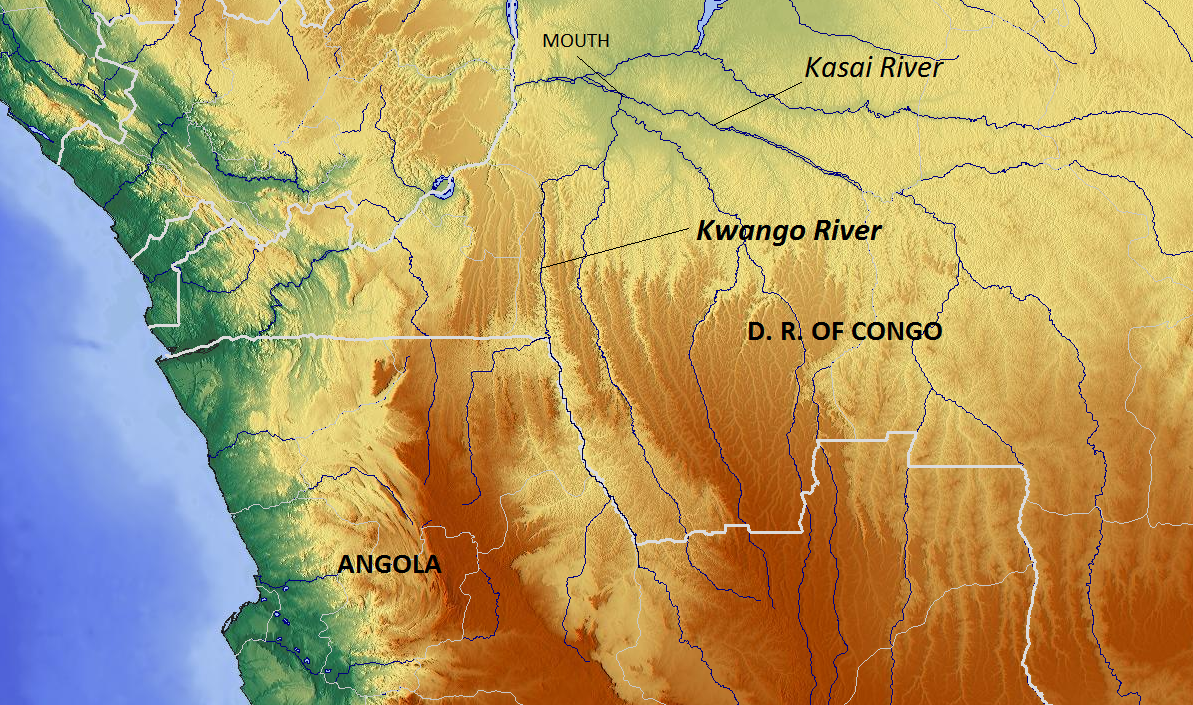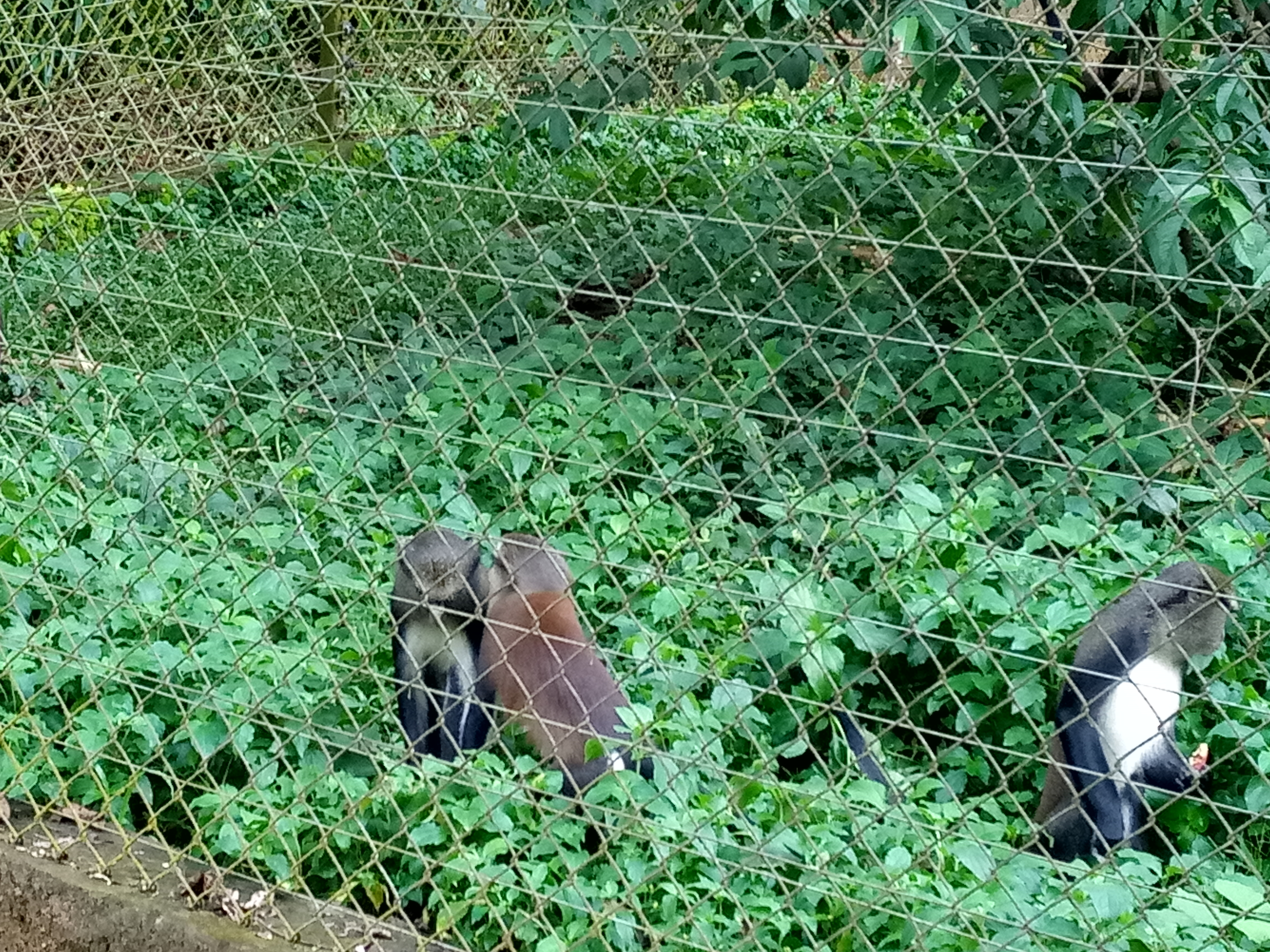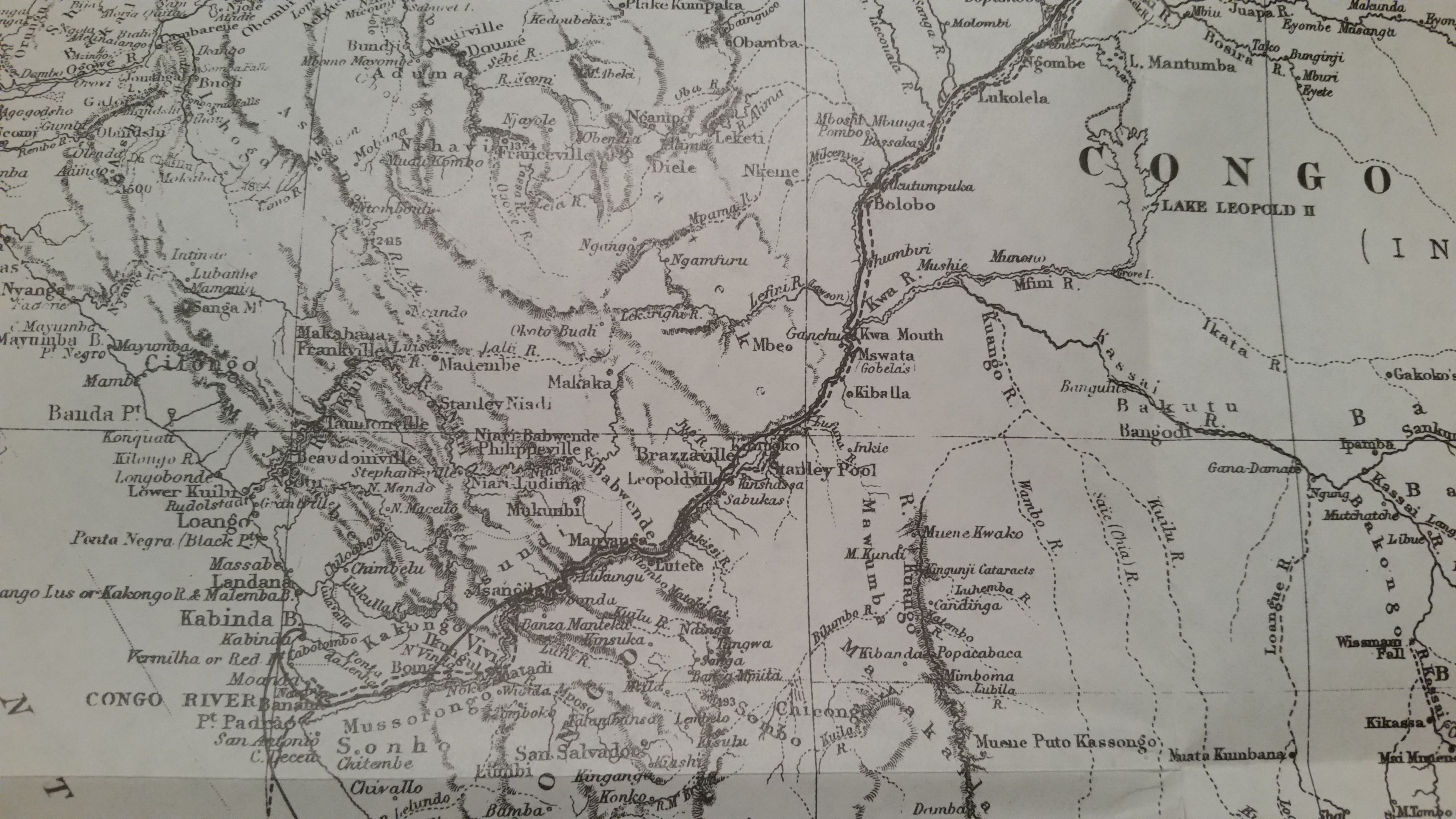|
Angolan Talapoin
The Angolan talapoin (''Miopithecus talapoin''), also known as the southern talapoin, is a species of primate in the family Cercopithecidae. Talapoins are the smallest species of Old-World monkeys. Description The fur of the Angolan talapoin is coarsely banded yellow-and-black on the back and flanks and white or greyish white on the chest and belly. The head is round and short-snouted with a hairless face which has a black nose skin bordering the face. The scrotum is coloured pink medially and blue laterally. They show mild sexual dimorphism in body size, the average head and body length is , the average tail length is and the average weight is for males and for females. Habitat The Angolan talapoin is limited to dense evergreen vegetation on the banks of rivers that often flow through miombo (''Brachystegia'') woodland or, as that is cleared, areas under cultivation. Distribution The Angolan talapoin occurs in the coastal watersheds south of the Congo River, including the ... [...More Info...] [...Related Items...] OR: [Wikipedia] [Google] [Baidu] |
Johann Christian Daniel Von Schreber
Johann Christian Daniel von Schreber (17 January 1739 in Weißensee, Thuringia – 10 December 1810 in Erlangen), often styled J.C.D. von Schreber, was a German naturalist. Career He was appointed professor of'' materia medica'' at the University of Erlangen in 1769. In 1774, he began writing a multivolume set of books entitled ''Die Säugethiere in Abbildungen nach der Natur mit Beschreibungen'', which focused on the mammals of the world. Many of the animals included were given a scientific name for the first time, following the binomial system of Carl Linnaeus. From 1791 until his death in 1810, he was the president of the German Academy of Sciences Leopoldina. He was elected a member of the Royal Swedish Academy of Sciences in 1787. In April 1795, he was elected a Fellow of the Royal Society Numerous honors were bestowed on him, including the office of an imperial count palatine. Schreber also wrote on entomology, notably ''Schreberi Novae Species Insectorvm''. His herba ... [...More Info...] [...Related Items...] OR: [Wikipedia] [Google] [Baidu] |
Kwango River
The Cuango or Kwango ( pt, Rio Cuango) is a transboundary river of Angola and Democratic Republic of Congo. It is the largest left bank tributary of the Kasai River in the Congo River basin. It flows through Malanje in Angola. The Kwango River basin has large resources of diamonds in the Chitamba-Lulo Kimberlite Cluster in Lunda Norte Province, discovered in the main river channel and on flats and terraces in its flood plains. History The Rund Kingdom, which expanded to become the Lunda Empire, encompassed territory stretching from Kwango River to the Luapula River. Its rulers partook in the slave trade. Lunda's expansion in the valley promoted a common political and cultural heritage while also promoting slave trading, accounting for the low population densities between the Kwango and Kwilu rivers.Ogot, p.607 The Portuguese colonized the Kwango River valley and usurped the Kingdom of Kasanje. The Kwango River was subject to a Portuguese treaty signing in Lisbon on May ... [...More Info...] [...Related Items...] OR: [Wikipedia] [Google] [Baidu] |
Mammals Described In 1774
Mammals () are a group of vertebrate animals constituting the class Mammalia (), characterized by the presence of mammary glands which in females produce milk for feeding (nursing) their young, a neocortex (a region of the brain), fur or hair, and three middle ear bones. These characteristics distinguish them from reptiles (including birds) from which they diverged in the Carboniferous, over 300 million years ago. Around 6,400 extant species of mammals have been described divided into 29 orders. The largest orders, in terms of number of species, are the rodents, bats, and Eulipotyphla (hedgehogs, moles, shrews, and others). The next three are the Primates (including humans, apes, monkeys, and others), the Artiodactyla (cetaceans and even-toed ungulates), and the Carnivora (cats, dogs, seals, and others). In terms of cladistics, which reflects evolutionary history, mammals are the only living members of the Synapsida (synapsids); this clade, together with Saurops ... [...More Info...] [...Related Items...] OR: [Wikipedia] [Google] [Baidu] |
Mammals Of Angola
This is a list of the mammal species recorded in Angola. Of the mammal species in Angola, one is critically endangered, five are endangered, eight are vulnerable, and ten are near threatened. There are 291 extant species of mammals in Angola and 67 fossil species. The following tags are used to highlight each species' conservation status as assessed by the International Union for Conservation of Nature: Some species were assessed using an earlier set of criteria. Species assessed using this system have the following instead of near threatened and least concern categories: Order: Afrosoricida (tenrecs and golden moles) ---- The order Afrosoricida contains the golden moles of southern Africa and the tenrecs of Madagascar and Africa, two families of small mammals that were traditionally part of the order Insectivora. *Family: Tenrecidae (tenrecs) **Subfamily: Potamogalinae ***Genus: '' Potamogale'' **** Giant otter shrew, ''Potamogale velox'' LC *Family: Chrysochloridae **Su ... [...More Info...] [...Related Items...] OR: [Wikipedia] [Google] [Baidu] |
Gabon Talapoin
The Gabon talapoin (''Miopithecus ogouensis''), also known as the northern talapoin, is a small species of African monkey native to riparian habitats in Cameroon, Equatorial Guinea, Gabon, the western Republic of the Congo and the far western Democratic Republic of Congo. It may have been introduced to Bioko and the Canary Islands. Classified in the genus ''Miopithecus'', it was given the name ''Miopithecus ogouensis'', based on the River Ogooué, distinguishing it from the other species, the Angolan talapoin, also known as '' Miopithecus talapoin''. Gabon talapoins are large headed monkeys with yellow-olive tinted coating, and can be differentiated from the Angolan talapoin by its flesh-coloured ears (not blackish). They are always found near watercourses, and are capable of diving and swimming away when disturbed. Males and females live together in mixed groups, but rarely interact with each other outside of mating season. Females tend to give birth annually during the rai ... [...More Info...] [...Related Items...] OR: [Wikipedia] [Google] [Baidu] |
Guenons
The guenons (, ) are Old World monkeys of the genus ''Cercopithecus'' (). Not all members of this genus have the word "guenon" in their common names; also, because of changes in scientific classification, some monkeys in other genera may have common names that include the word "guenon". Nonetheless, the use of the term guenon for monkeys of this genus is widely accepted. All members of the genus are endemic to sub-Saharan Africa, and most are forest monkeys. Many of the species are quite local in their ranges, and some have even more local subspecies. Many are threatened or endangered because of habitat loss. The species currently placed in the genus ''Chlorocebus'', such as vervet monkeys and green monkeys, were formerly considered as a single species in this genus, ''Cercopithecus aethiops''. In the English language, the word "guenon" is apparently of French origin. In French, ''guenon'' was the common name for all species and individuals, both males and females, from the ge ... [...More Info...] [...Related Items...] OR: [Wikipedia] [Google] [Baidu] |
Kasai River
The Kasai River ( ; called Cassai in Angola) is a tributary (left side) of the Congo River, located in Central Africa. The river begins in central Angola and flows to the east until it reaches the border between Angola and the Democratic Republic of the Congo, where it turns north and serves as the border until it flows into the DRC. From Ilebo, between the confluences with Lulua river and Sankuru river, the Kasai river turns to a westerly direction. The lower stretch of the river from the confluence with Fimi river, is known as the Kwa(h) River, before it joins the Congo at Kwamouth northeast of Kinshasa. The Kasai basin consists mainly of equatorial rainforest areas, which provide an agricultural land in a region noted for its infertile, sandy soil. It is a tributary of Congo river and diamonds are found in it. Around 60% of diamonds in Belgium go from Kasai river for cutting and shaping. Exploration Henry Morton Stanley reached the confluence on 9 March 1877, calling the r ... [...More Info...] [...Related Items...] OR: [Wikipedia] [Google] [Baidu] |
Democratic Republic Of The Congo
The Democratic Republic of the Congo (french: République démocratique du Congo (RDC), colloquially "La RDC" ), informally Congo-Kinshasa, DR Congo, the DRC, the DROC, or the Congo, and formerly and also colloquially Zaire, is a country in Central Africa. It is bordered to the northwest by the Republic of the Congo, to the north by the Central African Republic, to the northeast by South Sudan, to the east by Uganda, Rwanda, and Burundi, and by Tanzania (across Lake Tanganyika), to the south and southeast by Zambia, to the southwest by Angola, and to the west by the South Atlantic Ocean and the Cabinda exclave of Angola. By area, it is the second-largest country in Africa and the 11th-largest in the world. With a population of around 108 million, the Democratic Republic of the Congo is the most populous officially Francophone country in the world. The national capital and largest city is Kinshasa, which is also the nation's economic center. Centered on the Cong ... [...More Info...] [...Related Items...] OR: [Wikipedia] [Google] [Baidu] |
Angola
, national_anthem = " Angola Avante"() , image_map = , map_caption = , capital = Luanda , religion = , religion_year = 2020 , religion_ref = , coordinates = , largest_city = capital , official_languages = Portuguese , languages2_type = National languages , languages2 = , ethnic_groups = , ethnic_groups_ref = , ethnic_groups_year = 2000 , demonym = , government_type = Unitary dominant-party presidential republic , leader_title1 = President , leader_name1 = João Lourenço , leader_title2 = Vice President , leader_name2 = Esperança da CostaInvestidura do Pr ... [...More Info...] [...Related Items...] OR: [Wikipedia] [Google] [Baidu] |
Cuvo River
The Cuvo is a river in central Angola. The river mouth is at the Atlantic Ocean at Benguela Bay, in Cuanza Sul Province. Cuvo is its name in its upper reaches; its lower course is called the Keve or Queve. The river is navigable upstream to Binga Falls near Gabela. Its main tributaries include the Cussoi River. The river may be the southern extant of the range of the African manatee. The river wetland floodplain and Kumbira Forest is part of an Important Bird Area with several rare species. The river mouth has a mangrove stand. , Ramsar Sites Information Service See also *List of rivers of Angola
This is a list of rivers in Angola. This list is a ...
[...More Info...] [...Related Items...] OR: [Wikipedia] [Google] [Baidu] |
Primate
Primates are a diverse order of mammals. They are divided into the strepsirrhines, which include the lemurs, galagos, and lorisids, and the haplorhines, which include the tarsiers and the simians ( monkeys and apes, the latter including humans). Primates arose 85–55 million years ago first from small terrestrial mammals, which adapted to living in the trees of tropical forests: many primate characteristics represent adaptations to life in this challenging environment, including large brains, visual acuity, color vision, a shoulder girdle allowing a large degree of movement in the shoulder joint, and dextrous hands. Primates range in size from Madame Berthe's mouse lemur, which weighs , to the eastern gorilla, weighing over . There are 376–524 species of living primates, depending on which classification is used. New primate species continue to be discovered: over 25 species were described in the 2000s, 36 in the 2010s, and three in the 2020s. Primates have ... [...More Info...] [...Related Items...] OR: [Wikipedia] [Google] [Baidu] |


.jpg)


.jpg)